How Long Can a Cat6/Cat7 Ethernet Cable Be?
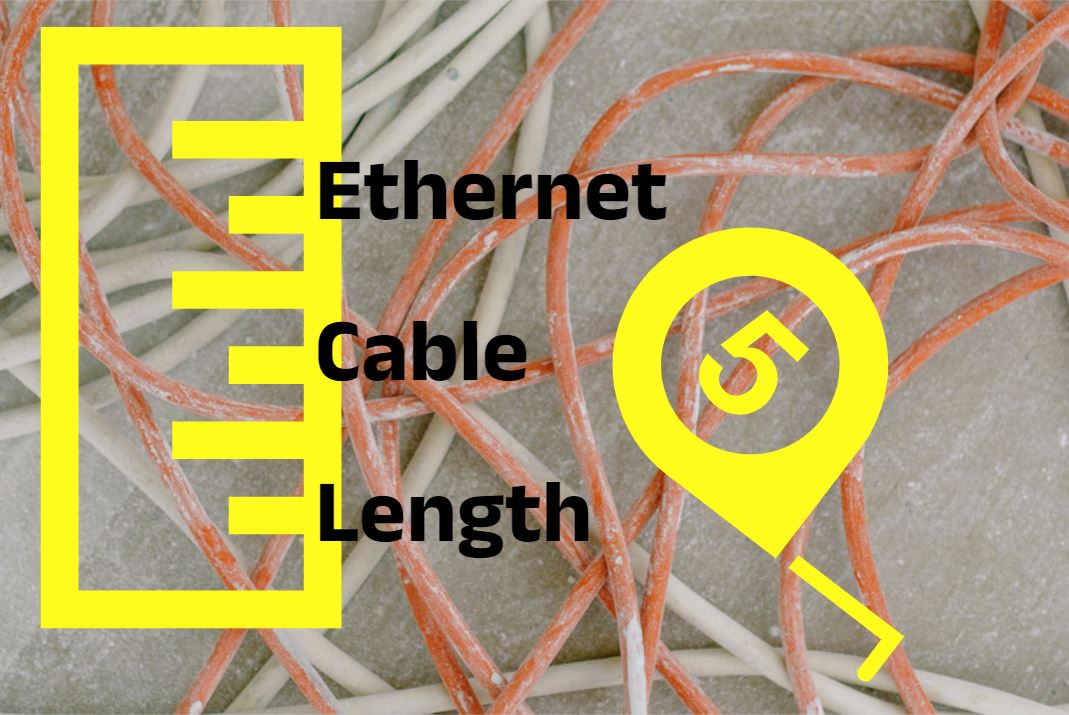
Table of Contents
Cat6 Ethernet Cable Max Length
In accordance with the ANSI/TIA/EIA standard for Category 5e and Category 6 and 6a copper cables, the maximum length of the segment cable is 100 meters (328 feet).
It all depends on the quality of the wire, connectors, crimping, and equipment.
Some manufacturers put a power reserve in some models, and then it can easily work in modes exceeding the standard ones (without guarantees).
There are two types of Category 6 cable with different lengths:
- A standard Cat6 cable allows a higher signal frequency of 250 MHz and has a maximum use distance of 55 meters without shielding for 10GBASE-T.
- Cat6a cable, also known as Augmented Cat6, has a frequency of 500 MHz and can operate at a maximum distance of 100 meters on 10GBASE-T.
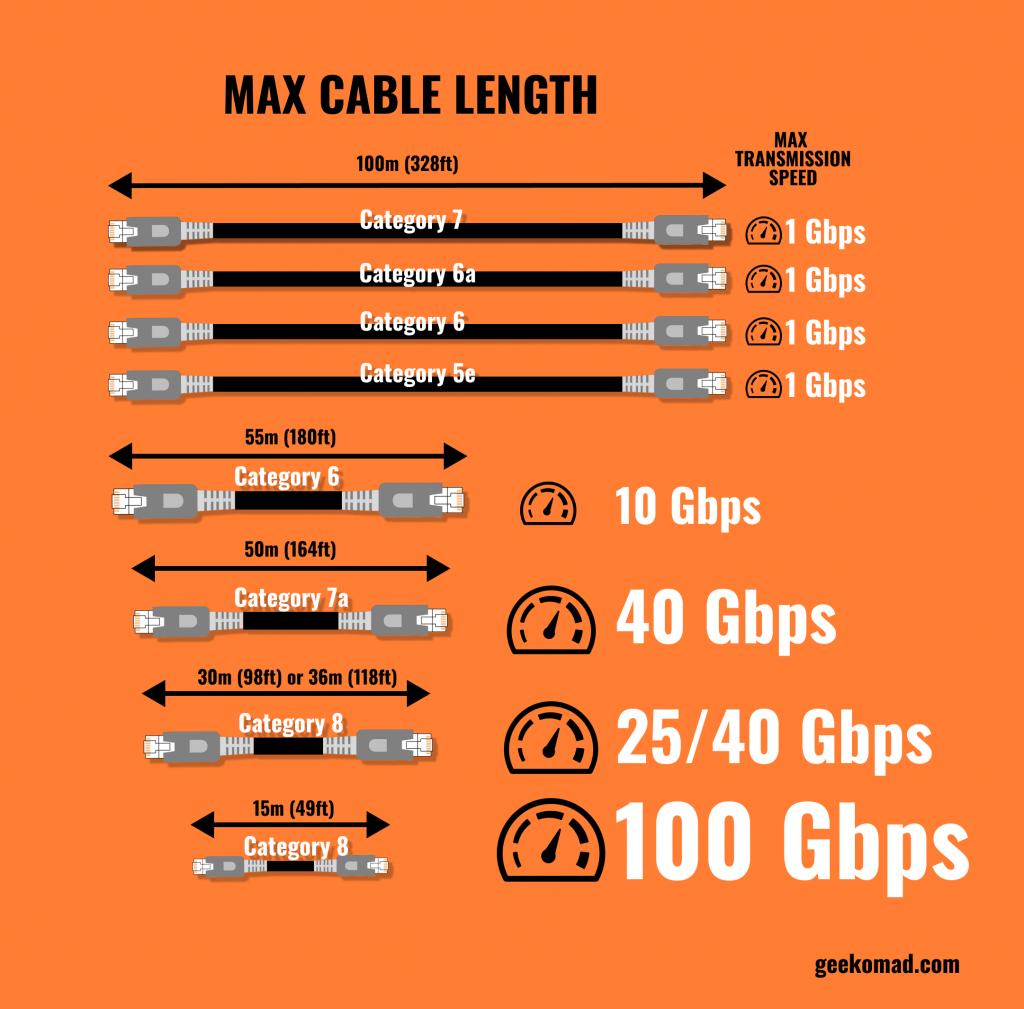 The maximum cable length of categories 5e, 6, 6a, 7, 7a, and 8
The maximum cable length of categories 5e, 6, 6a, 7, 7a, and 8
How Long Can a Cat 7 Ethernet Cable Be?
It offers a 100-meter channel using shielded cables and is designed to transmit signals with a frequency of 600 MHz.
How Can You Extend the LAN Cable?
To extend the cable crimped on both sides, you can use an RJ45 Network Cable Coupler. But do not forget that you can always buy or make a longer cable or connect the device via Wi-Fi.
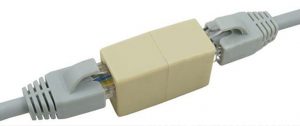
You can extend the internet cable by twisting it.
We do not recommend it. You can extend the Internet cable by twisting it. The method is simple but rather unreliable. The problem with this method is that the electrical signal can be lost when passing through broken wires, which can cause interference, packets to disappear, and Internet speed to drop.
It is enough to strip the cable at both ends and twist its color into color. For insulation, use an insulating tape or a shrink tube. It is necessary to securely twist each cable and insulate it.
The Experience in Testing the Length of the Cable
Experts did experiments in the cheap segment of the cable. When approaching the threshold of length standards, it begins to glitch noticeably, but at the same time, it costs 2-3 times cheaper than what is not glitchy. Our engineer had experience with network adapters: Intel normally held a little more than 100 meters, and Realtek and Marvel could not stand it at 80. I also had a similar experience when the cable was not standard (2 of the 8 conductors were thick aluminum, it looks like a power cable), and there was also about a 100-meter segment. Intel was able to raise the network, but Realtek screwed up.

From other high-quality brands: Broadcom, at one time, was 3Com.
For network adapters, hubs and switches, the results are about the same. But we have not measured the distance ourselves.
I think if the segment length approaches the maximum, the best solution is to put a repeater in the middle or an intermediate hub/switch.
Ethernet Length Limits. The Longest Ethernet Cable
| Cat5e | Cat6 | Cat6a | Cat7 | Cat7a | Cat8 | |
| Frequency | 100MHz | 250MHz | 500MHz | 600MHz | 1000MHz | 2000MHz |
| Maximum transmission speed | 1 Gbps | 1 Gbps/10 Gbps | 10 Gbps | 10 Gbps | 40Gbps/100Gbps | 25 Gbps/40 Gbps |
| Distance | 100m | 100m (1 Gbps)/55m (10 Gbps) | 100m | 100m | 50m (40Gbps) / 15m (100Gbps) | 30m or 36m |
According to the table, the longest Ethernet cables for categories 5e, 6, 6a, 7 are 100 meters or 328 feet long.
Where did the Limit of 100 Meters for the Length of the Ethernet Segment Come From?
The maximum length of 100 m is determined by the speed of signal propagation in the medium (we are talking only about Ethernet). Accordingly, the minimum package size is such that it fits entirely in the cable. In this case, if the port on the second side also starts transmitting, the first one will have time to hear it until it finishes transmitting its packet and realizes that the packet will not be delivered. I.e., there will be a certain collision at the hardware level. Then it will already be sorted out by the adapters themselves, with the help of random delays and retransmission.
The minimum packet size of a gigabit is significantly higher – just for this reason, but there the standard is more complicated, and at the packet level, it is allowed to collect several portions of data in one transmission.
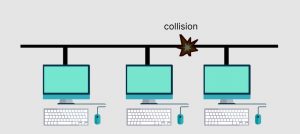
Accordingly, if the boards are good and the cable is good, then it will be possible to work at a distance of more than 100m. The higher the load, the more collisions there will be, and when they exceed 100 m, they cease to be determined by hardware.
Thus, having made a cable of more than 100 meters and having pinged, you will see a good connection. But after giving a full load, you will get a bunch of problems.
If the distance is greater, then either use another technology (for example, optics, in which there are different fibers for receiving and transmitting) or put a signal repeater (switch) in the middle.
In fact, the easiest way is the proper location of the switching cabinet in the building. When located in the center, a few corners will remain out of reach.
The connection of different buildings needs to be thought out in any case because there are other problems besides 100 meters – for example, different phases of equipment supply, step voltage, lightning protection, etc.
The Reason for the Limitation of the Cable Length Lies in the CSMA/CD Technology.
CSMA/CD – Carrier Provide multiple access with collision detection. This is when we have one bus (one data medium) to which several stations are connected (Multiple access). Each station monitors the status of the bus – whether there is a signal from another station in it (the meaning of the carrier). If suddenly two devices started transmitting at the same moment, then both of them should detect it (Collision Detection). Yes, it’s all about half-duplex networks. Therefore, if your eyes are focused exclusively on a bright 10-gigabit future, this article is not for you.
First of all, I want everyone to understand that the speed of signal transmission in the environment does not depend in any way on the standard used. In local networks, the pulse propagation speed in a copper cable is about 2/3 of the speed of light. As it was correctly written in one magazine: you can speak fast or slow, but the speed of sound does not change from this.
In modern networks, collisions are excluded because we no longer have a common bus, and almost always, all devices work in full-duplex mode. That is, we have only two nodes at the end of one cable and separate pairs for receiving and transmitting. Therefore, the CSMA/CD mechanism is no longer available in 10 Gbit Ethernet.
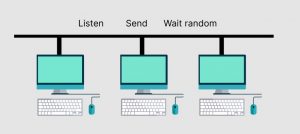
But before giving an answer to the question about the length of the network cable, we will have to plunge a little into the theory of networks and first introduce the concept of big time. This value means how long it takes the interface to deliver 1 bit to the environment. That is, if Fast Ethernet sends 100,000,000 bits per second to the cable, then big time is 1b/100,000,000 b/s=10^-8 s or 10 nanoseconds.
Every 10 nanoseconds, the Fast Ethernet port can send one bit to the environment. For comparison, Gigabit Ethernet sends 1 bit every nanosecond.
If we talk about IFG, then the station should pause exactly 96 bit-timings before sending each frame. Fast Ethernet, for example, should wait for 960 nanoseconds (0.96 microseconds) and Gbit Ethernet 96 nanoseconds.
So, to fulfill the condition, the concept of quantum or Slot time is introduced – the minimum size of a data block that can be transmitted over the network to Ethernet. And it is this quantum that should stretch over the entire segment. For Ethernet and Fast Ethernet, the minimum size is 64 bytes – 512 bits. To transmit it to the FE port, you will need 10 ns * 512 = 5120 ns or 5.12 microseconds.
Hence the 64-byte limit on the minimum size of an Ethernet frame.
That is, a 64-byte data block will have 5.12 microseconds to travel on the bus and return to the sender in case of a collision. Let’s try to calculate the distance head-on: (5,12 * 10^-6)*(2/3*3*10^8)/2=512 meters.
I will explain the formula: travel time (5.12 microseconds translated into seconds) * 2/3 of the speed of light (the speed of propagation of the signal in a copper medium in m / s) and divide by 2 – in order to provide for the worst case of collision when the signal has to go all the way back to the sender. It seems to be a familiar figure – 500 meters, but the problem is that the limit for Fast Ethernet is 100 meters to the hub (200 to the farthest station).
This is where delays on hubs and repeaters come into play. They say that they are all calculated and taken into account in the final formula, but the traces are lost. No matter how much I tried to find this calculation formula with a result of 100 meters, I could not find it. As a result, it is known what the restriction is due to, but not where figure 100 came from.
Gigabit Ethernet Cable Length
When developing Gbit Ethernet, a very important question arose – the transmission time of one bit was already 1 ns, and only 0.512 microseconds were needed to transfer one portion of data. Even when calculating in my formula without taking into account delays, a length of 50 meters is obtained (and 20 meters taking into account these values). Very little, and therefore it was decided, instead of reducing the distance (as was the case with the Ethernet->Fast Ethernet transition), to increase the minimum data size to 512 bytes – 4096 bits.
The transmission time of such a portion of data remained approximately the same – 4 seconds versus 5. Here, of course, there is another point that it is not always possible to dial such a size – 4 kB of data, so at the end of the frame, after the FCS field, the missing amount of data is added. Considering that we have long abandoned the common bus, we have a separate environment for receiving and transmitting, and there are no collisions as such. All this looks like crutches. Therefore, in the 10 Gbit Ethernet standard, the CSMA/CD mechanism was abandoned altogether.
Overcoming Length Restrictions
So, all of the above concerning outdated half-duplex networks with a common bus. What does this have to do with the present moment, you ask? Can we pull UTP kilometers, or can’t we?
Unfortunately, after all, the hundred-meter limit has a different nature. Even at 120 meters with a conventional cable, in most cases, many switches will not be able to raise the link. This is due to both the power of the switch ports and the quality of the cable. It’s about attenuation and leads and distortion of the signal during transmission.
A conventional twisted pair is affected by electromagnetic interference and does not guarantee the protection of the transmitted information. But first of all, let’s look at the attenuation. Our typical UTP cable has at least 27 twists per meter and transmits data at a frequency of 100 MHz. The so-called linear attenuation is the attenuation of the signal at each meter of the medium. According to the standards, the attenuation should not exceed 24 dB. On average, this value is about 22 dB for a conventional UTP cable, which means a 158-fold attenuation of the original signal.
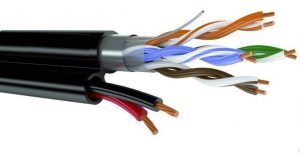
It turns out that attenuation by 1 dB occurs every 4.5 meters. If we take the cable length of 150 meters, then the attenuation is already about 33 Db, and the original signal will decrease by a factor of 1995, which is already very significant.
Plus, the mutual influence of pairs is added to this – transient attenuation. This is the name of the process when there are leads in parallel conductors. That is, part of the energy is spent on an exciting current in an adjacent cable. Let’s take into account possible interference from power cables that I can pass nearby, and the limit of 100 meters becomes completely logical.
Why then was there no such restriction in coaxial networks? The fact is that the attenuation in the cable depends on the resistance /cross-section of the cable and the frequency. Let’s remember now that thick Ethernet uses a cable with a 2.17 mm conductor. Plus, Ethernet on a coaxial cable worked at a frequency of 10 Mhz. And the higher the frequency, the higher the attenuation. Why do you think the analog radio signal is transmitted to the antennas not by such a convenient twisted pair but by thick feeders?
By the way, the word Base in Ethernet standards means Baseband and says that only one device can transmit data through the medium at the same time. Modulation/multiplexing is not used. In contrast to it, Broadband imposes several different signals on one carrier, and on the other hand, each individual signal is extracted from the carrier.
In fact, given that the attenuation is due to the characteristics and quality of the cable, it is possible to achieve significantly better results using a more suitable one.
There are already other requirements for Gigabit. And in general, the higher the transmission speed, the more parameters have to be taken into account, which is why in 10Gbit Ethernet, there is only nominal support for the copper medium, and optics are preferred.
In general, summing up all of the above, the figure of 100 meters is a good margin that guarantees work even in a half-duplex on a cable of not the best quality. It is caused by the attenuation and operation of the CSMA/CD mechanism.
